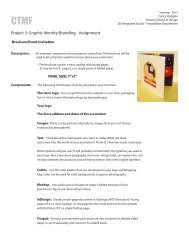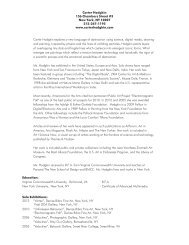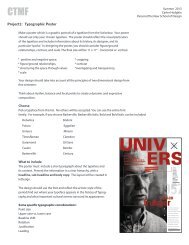Speed: Aberrations of Time and Movement Oliver ... - Carter Hodgkin
Speed: Aberrations of Time and Movement Oliver ... - Carter Hodgkin
Speed: Aberrations of Time and Movement Oliver ... - Carter Hodgkin
You also want an ePaper? Increase the reach of your titles
YUMPU automatically turns print PDFs into web optimized ePapers that Google loves.
people like ourselves <strong>and</strong> yet not like ourselves, frozen in careless attitudes, caught in mid-gesture . . .<strong>and</strong> sliding down the air with wings flapping slowly <strong>and</strong> at the speed <strong>of</strong> an exceptionally languid snail--wasa bee."The <strong>Time</strong> Machine" was published in 1895, when there was intense interest in the new powers <strong>of</strong>photography <strong>and</strong> cinematography to reveal details <strong>of</strong> movements inaccessible to the unaided eye.Etienne-Jules Marey, a French physiologist, had been the first to show that a galloping horse at one pointhad all four hooves <strong>of</strong>f the ground. His work, as the historian Marta Braun brings out, was instrumental instimulating Eadweard Muybridge's famous photographic studies <strong>of</strong> motion. Marey, in turn stimulated byMuybridge, went on to develop high-speed cameras which could slow <strong>and</strong> almost arrest the movements<strong>of</strong> birds <strong>and</strong> insects in flight; <strong>and</strong>, at the opposite extreme, to use time-lapse photography to acceleratethe otherwise almost imperceptible movements <strong>of</strong> sea urchins, starfish, <strong>and</strong> other marine animals.I wondered sometimes whether the speeds <strong>of</strong> animals <strong>and</strong> plants could be very different from what theywere: how much they were constrained by internal limits, how much by external--the gravity <strong>of</strong> the earth,the amount <strong>of</strong> energy received from the sun, the amount <strong>of</strong> oxygen in the atmosphere, <strong>and</strong> so on. So Iwas fascinated by yet another Wells story, "The First Men in the Moon," with its beautiful description <strong>of</strong>how the growth <strong>of</strong> plants was dramatically accelerated on a celestial body with only a fraction <strong>of</strong> theearth's gravity:With a steady assurance, a swift deliberation, these amazing seeds thrust a rootlet downward to the earth<strong>and</strong> a queer little bundle-like bud into the air. . . . The bundle-like buds swelled <strong>and</strong> strained <strong>and</strong> openedwith a jerk, thrusting out a coronet <strong>of</strong> little sharp tips . . . that lengthened rapidly, lengthened visibly evenas we watched. The movement was slower than any animal's, swifter than any plant's I have ever seenbefore. How can I suggest it to you--the way that growth went on? . . . Have you ever on a cold day takena thermometer into your warm h<strong>and</strong> <strong>and</strong> watched the little thread <strong>of</strong> mercury creep up the tube? Thesemoon plants grew like that.Here, as in "The <strong>Time</strong> Machine" <strong>and</strong> "The New Accelerator," the description was irresistibly cinematic,<strong>and</strong> made me wonder if the young Wells had seen, or experimented with, time-lapse photography <strong>of</strong>plants, as I had.A few years later, when I was a student at Oxford, I read William James's "Principles <strong>of</strong> Psychology," <strong>and</strong>there, in a wonderful chapter on "The Perception <strong>of</strong> <strong>Time</strong>," I found this description:We have every reason to think that creatures may possibly differ enormously in the amounts <strong>of</strong> durationwhich they intuitively feel, <strong>and</strong> in the fineness <strong>of</strong> the events that may fill it. Von Baer has indulged in someinteresting computations <strong>of</strong> the effect <strong>of</strong> such differences in changing the aspect <strong>of</strong> Nature. Suppose wewere able, within the length <strong>of</strong> a second, to note 10,000 events distinctly, instead <strong>of</strong> barely 10, as now; ifour life were then destined to hold the same number <strong>of</strong> impressions, it might be 1000 times as short. Weshould live less than a month, <strong>and</strong> personally know nothing <strong>of</strong> the change <strong>of</strong> seasons. If born in winter, weshould believe in summer as we now believe in the heats <strong>of</strong> the Carboniferous era. The motions <strong>of</strong>organic beings would be so slow to our senses as to be inferred, not seen. The sun would st<strong>and</strong> still in thesky, the moon be almost free from change, <strong>and</strong> so on. But now reverse the hypothesis <strong>and</strong> suppose abeing to get only one 1000th part <strong>of</strong> the sensations that we get in a given time, <strong>and</strong> consequently live1000 times as long. Winters <strong>and</strong> summers will be to him like quarters <strong>of</strong> an hour. Mushrooms <strong>and</strong> theswifter-growing plants will shoot into being so rapidly as to appear instantaneous creations; annual shrubswill rise <strong>and</strong> fall from the earth like restlessly boiling-water springs; the motions <strong>of</strong> animals will be asinvisible as are to us the movements <strong>of</strong> bullets <strong>and</strong> cannon-balls; the sun will scour through the sky like ameteor, leaving a fiery trail behind him, etc. That such imaginary cases (barring the superhumanlongevity) may be realized somewhere in the animal kingdom, it would be rash to deny.







